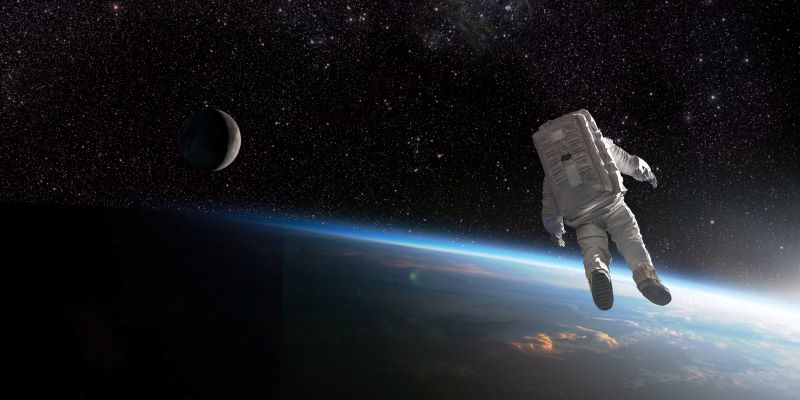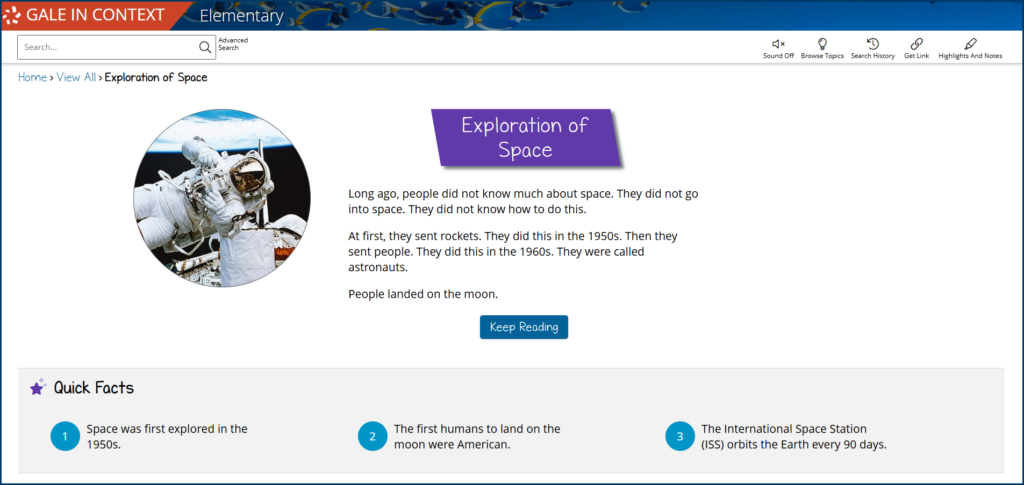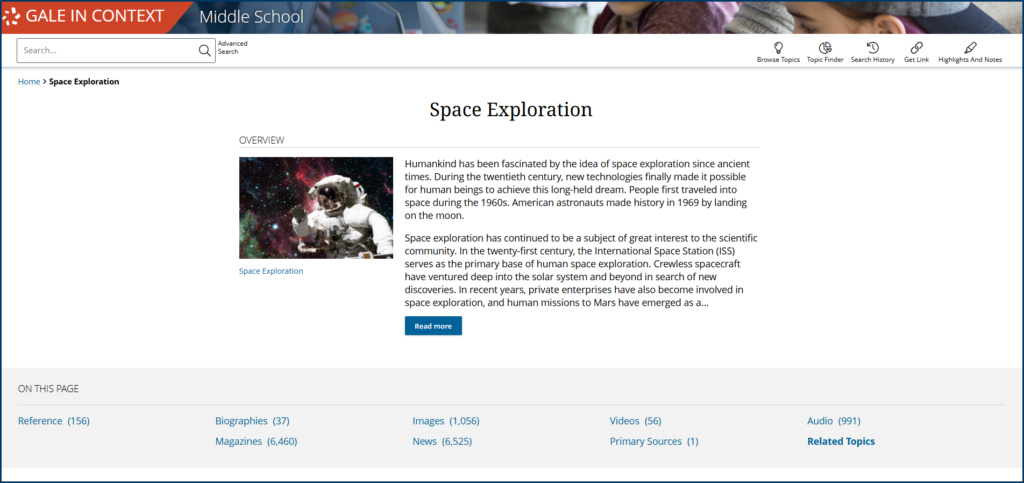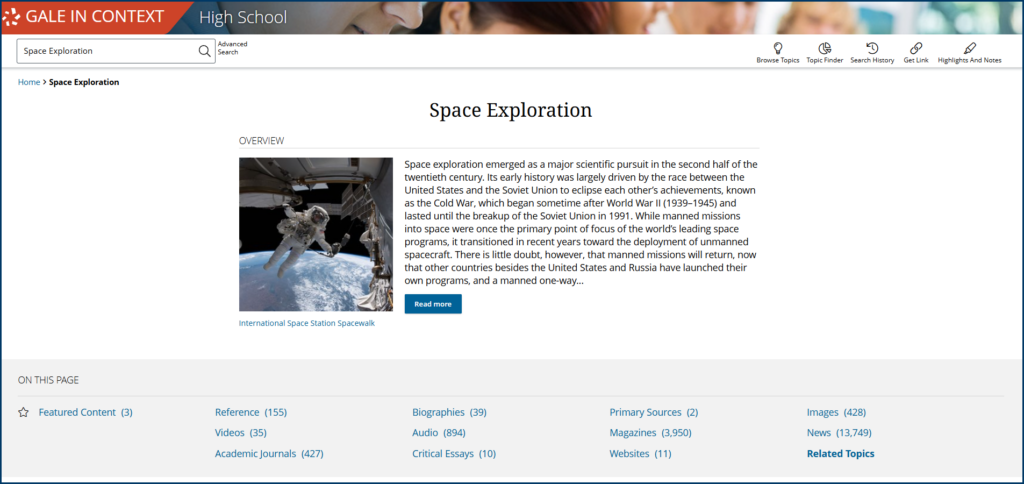| By Gale Staff |
As summer break approaches, teachers of all grades are seeking out exciting classroom topics to keep students engaged. With National Space Day on May 2, look no further than Gale In Context for space-related content, discussion starters, and activity ideas!
Designed to nurture students’ curiosity, Gale In Context offers educators an ad-free database ideal for growing student research skills. To support individual learning styles, students can toggle between reading levels and adjust the font and spacing. Teachers can also rely on Gale In Context to help create curriculum-aligned lesson plans, saving valuable time in busy end-of-the-year schedules.
You can take your space-themed lesson plan in infinite directions, and Gale In Context can accommodate whatever path you choose or grade you teach. From an overview of NASA and the Moon landings to thought-provoking discussions around SpaceX and a potential colony on Mars, Gale can help you pivot from the basics to unpack increasing complexity to foster student learning.
Introduce Elementary Students to Space Exploration
Introducing students to space exploration is a great way to spark further interest in STEM. Turn to Gale In Context: Elementary to research space exploration’s first significant milestones. The database is highly visual, and designed to support young learners’ developing reading and research skills.
When the former Soviet Union successfully launched Sputnik into space in 1957, the United States had to respond in order to remain competitive in the Space Race. In 1958, the US pioneered its first satellite, and President Eisenhower signed the National Aeronautics and Space Act, creating the federally-funded National Aeronautics and Space Administration (NASA).
A decade later, Neil Armstrong took his first steps on the moon. We have since discovered the existence of black holes, sent objects beyond the solar system, and maintained a continuous human presence on the International Space Station (ISS).
As a class, reflect on the incredible potential of human ingenuity when we mobilize and work together toward a shared goal.
Activity Idea: Meet famous animal astronauts! There’s Laika (Russian for “barker”), a stray dog from Moscow who became the first living creature to orbit the Earth. There’s Miss Baker, a one-pound squirrel monkey who traveled at 300 miles per hour in space and made it back to Earth alive. From fruit flies and mice to frogs and tardigrades, animal astronauts are essential to space exploration. As a class, discuss why scientists send animals to space.
Meet Real Astronauts with Your Middle Schoolers
Gale In Context: Middle School can help your students make the jump from elementary-level concepts to more advanced content.
It takes a huge network of people to launch rockets into outer space, from politicians to mathematicians. But no one captures the imagination in quite the same way as the courageous astronauts who risk their lives for science. To date, fewer than 1,000 people have made the journey. Because of the rarity and danger associated with the profession, astronauts can seem almost superhuman. Invite your students to learn the stories and backgrounds of the people inside the spacesuits, and what they endure to make it into space.
During the launch, astronauts undergo 3 g forces on their bodies—three times the pressure of the Earth’s normal gravity. But physical stress is just the beginning; astronauts must be mentally tough to cope with the unpredictability of day-to-day life in orbit. In 2024, two astronauts got stuck in outer space after issues with their Boeing Starliner capsule turned a weeklong stay into nine months. To survive the job’s intense physical and mental pressures, astronauts complete years of rigorous training.
Using Gale In Context: Middle School, introduce your students to the people within the space suit.
Sally Ride
The brilliant and fearless Sally Ride was the first U.S. woman in outer space. While completing her graduate work in physics at Stanford University, Ride happened upon a NASA job advertisement seeking mission specialists. Out of more than 8,000 applicants, NASA selected Ride and 34 other candidates for its astronauts-in-training program.
A few years later, on June 18, 1983, Ride boarded a space shuttle while thousands of spectators cheered her on—many sporting T-shirts reading “Ride, Sally Ride.” Her bravery and humor captivated Americans, making her a folk hero and an inspiration to people worldwide.
Christina Koch
One of the women Ride inspired is Christina Koch. Born in 1979 in Grand Rapids, Michigan, Koch always dreamed of becoming an astronaut. She joined her school’s Rocket Club and even attended Space Camp for teenagers. She would later earn degrees in electrical engineering and physics.
In 2013, NASA accepted Koch into its astronaut candidate program, and in 2019, Koch joined a mission to the ISS as a flight engineer. While aboard the ISS, Koch released a speech in 2019 for Women’s Equality Day. Koch shared, “I have truly been inspired by the struggle and triumphs of so many women that dare to break new ground in all aspects of society, and those who have pushed the boundaries of human imagination.”
Later that fall, Koch participated in the first-ever all-female spacewalk during a seven-hour mission to replace a failed battery unit on the ISS.
Activity Idea: NASA has selected more than 300 people to travel to outer space. Choose one of them to research. Gale In Context: Middle School has dozens of biographical profiles on astronauts like Michael Collins, John Glenn, and Kalpana Chawla. Just search “Astronauts” and select “Biographies” to discover more.
Encourage students to reflect on the qualities that made people like Koch and Ride ideal candidates for the job. What drove them toward this career path? If given the chance, would your students like to travel to space?
Consider the Future of Space Exploration with High Schoolers
While space exploration still fires the imagination, the topic has become somewhat controversial. Against the backdrop of America’s growing wealth gap, industry privatization and space tourism have raised important questions about spending priorities. Additionally, space exploration contributes to atmospheric pollution as the planet warms and natural disasters become more severe and more frequent.
Conversely, the science of space exploration has contributed to human innovations both big and small, from viscoelastic memory foam insoles to robot-assisted surgeries. Space exploration boosts our economy, bolsters diplomacy through international partnerships like the ISS, and inspires a shared sense of wonder within us as a species.
Gale In Context: High School provides relevant and meaningful resources to help your high school students weigh these complexities at a more advanced level. This database embeds critical thinking questions and features current articles from top global news agencies. Dive into hot-button topics like SpaceX, Elon Musk’s privately-owned space enterprise. Despite significant failures and regulatory concerns, the company has achieved significant milestones, pioneering private spaceflight, Starlink satellite internet, and a recent rescue mission in space.
While some educators might recall when we first walked on the Moon, today’s high schoolers could witness the next frontier: Mars. Recent discoveries suggest Mars could be habitable. The red planet has an atmosphere that helps regulate its temperatures and might have liquid water underground. SpaceX has made Mars colonization a top priority.
Activity Idea: As a class, debate the colonization of Mars. Consider the possible benefits Martian exploration might offer: opening the door for technological advancement and international unity as nations and scientists work toward a common goal—even its potential role in humanity’s long-term survival. On the other hand, there are important factors and questions to weigh, such as the cost, the ecological and ethical concerns of altering another planet, and who stands to benefit when for-profit companies rather than government agencies are leading the effort.
Space exploration continues to inspire awe and wonder at any age, and Gale In Context is here to support you as your students’ academic needs and curiosity evolve. This National Space Day, celebrate the accomplishments of the space industry’s past and the perseverance of human curiosity as we continue shooting for the stars.
If your district does not subscribe to Gale, find your local representative and request a trial of our products.




